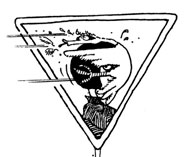
Hard hats
It is really hard to work out
The poor old coppers (bless ’em) appear to have no idea, at least in Tasmania, and neither does Standards Australia.
In Tassie, an unfortunate rider who had just bought a new helmet was told by the local Plod that she couldn’t wear it on the road because it didn’t have the familiar 5-tick sticker on it. And when her bike shop (which had sold her the helmet in good faith) checked with Standards, they were told by Daniel Chidgey, the Co-ordinator, Customer Information Service, “My understanding is that, yes, you have to have the 5-tick certification mark issued by SAI-Global to be able to use the helmet on the roads.”
Both the police and Daniel are, however, wrong and have been for six years (!).
In case you can’t be bothered following the whole sad story, here’s the summary:
Since December 17, 2003 (!), the Australian certification marketplace has been “opened up” to competitive privately owned companies. The days of the “5-ticks” being the only certification trademark are long gone and there are now seven companies that can test and approve helmets. We can’t list them here because we couldn’t find out what they all are (believe it or not), but they include BSI Management Systems (Australia & New Zealand) Pty Ltd, Global-Mark Pty Ltd, SAI Global Limited and TÜV Rheinland Australia Pty Limited.
Umm … so what do I do?
With the help of Maggie Zhu from TÜV Rheinland, we’ve come up with the following background story.
Before December 17, 2003, SAI Global was owned by Standards Australia International Limited (previously know as Standards Association of Australia) and delivered, via its subsidiary SAI Global, the product certification scheme commonly referred to as the “5-ticks”.
Standards Australia International was and still is a not-for-profit community-owned organisation, but on the above date, Standards Australia International divested itself of its subsidiary SAI Global and floated it on the Australian stock exchange.
Thus, since December 17, 2003, the product certification schemes commonly referred to as the “5-ticks” is operated and owned by SAI Global Limited, a publicly listed, privately owned company.
This has resulted in the “opening up” of the Australian certification marketplace, which removed in effect the “quasi” government-endorsed certification process delivered by a not-for-profit, community-owned organisation.
The Australian certification marketplace is now serviced by several Australian private companies.
Helmets must still comply with the standard AS/NZS 1698:2006 (as amended) Protective helmets for vehicle users. This standard superseded the standard AS 1698–1988 (as amended) Protective helmets for vehicle users on February 20, 2006.
The Australian Consumer & Competition Council (ACCC) Consumer Protection Notice (CPN) No. 9 of December 10, 1990, requires that protective helmets for motorcyclists comply with the Australian Standard 1698–1998. Unfortunately, CPN No. 9 has not been updated to reflect that AS 1698–1988 was superseded by AS/NZS 1698. Note that CPN No. 9 does not require a helmet to be certified or marked with a particular company’s certification trademark.
But what about the Australian Road Rules (ARRs)? These are basically a consistent set of rules that apply right across Australia and make it easier all round for road users. The ARRs were developed by the National Road Transport Commission, state and territory transport agencies, police and other organisations and approved by a majority vote of state transport ministers.
The latest version of the Australian Road Rules incorporates the amendments approved by the Australian Transport Council up to and including January 2008. The Australian Road Rules are model Rules only and have no legal effect, but they form the basis of Road Rules of each Australian state and territory. In these rules, an “approved motorbike helmet means a protective helmet for motorbike riders that is approved, for the Australian Road Rules, under another law of this jurisdiction.”
So the Australian Road Rules do not require a helmet to be certified or marked with a particular company’s certification trademark, either.
Neither do the New South Wales Road Rules. Referring to the legal definition, the NSW Road Rules 2008 requires the rider and a passenger of a motorbike that is moving, or is stationary but not parked, to wear an approved motorbike helmet.
“An approved motorbike helmet means a protective helmet for motorbike riders of a type approved by the authority,” in this case the RTA.
The NSW Road Rules do not require a helmet to be certified or marked with a particular company’s certification trademark.
As far as we can work out, the other states and territories vary in their requirements, but not by all that much.
Yes, but what do I do?
Well, when you buy your next helmet you might like to ask the shop whether the approval sticker and sewn-in label have, in fact, been issued by a company entitled to do so. But, providing the answer is affirmative, how do you know that’s true?
Don’t ask the police or Standards Australia …
For a listing of accredited bodies, you can try taking a look at www.jas-anz.com.au/index.php?option=com_content&task=blogcategory&id=44&Itemid=1, but it’s a real dog’s breakfast. If the police question you, point out to them that the triangle with the wavy-looking base on your sticker is the licensing mark. Good luck.
That whole shemozzle doesn’t seem acceptable to us. We will pursue this further.
